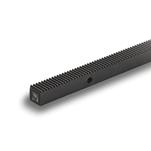Product description
Spur gears GN 7802 of plastic reduce both weight and noise while offering high corrosion resistance.
Spur gears of polyamide allow the transmission of significantly higher torques compared with gears made of other plastics. This makes them especially suited for applications with high torques at low speeds.
The spur gears have involute toothing with a pressure angle of 20°. More details about the design as well as shaping the hub or machining a keyway can be found in the technical information.
Specification
Plastic
Technopolymer (Polyamide PA)
- Glass fiber reinforced
- Temperature resistant up to 120 °C
- GrayGR

RoHS
On request
With keyway
With bore H9



